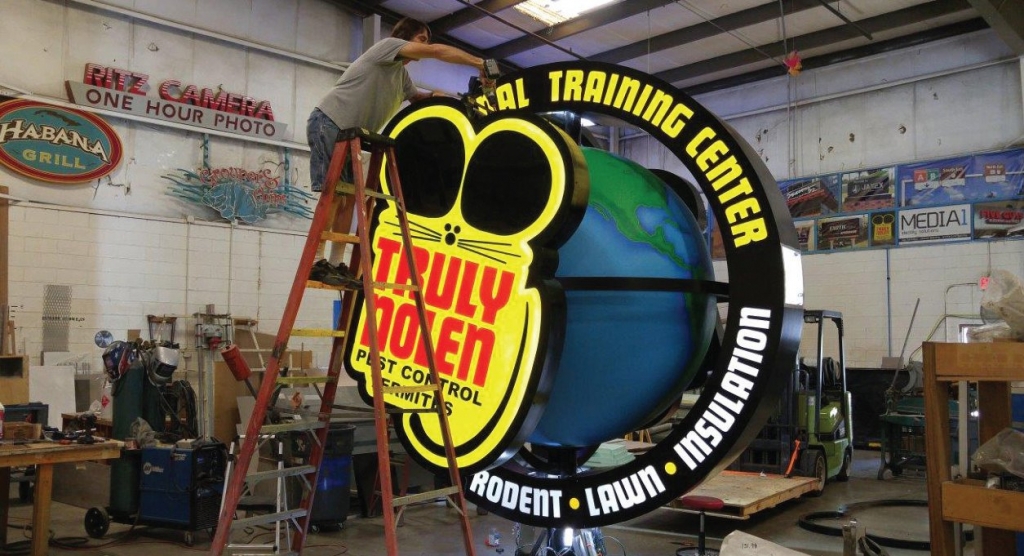When a longstanding client, Truly Nolen Termite & Pest Control, called my Media1 (M1) partner, Damon Coppola, to arrange a meeting to discuss their latest signage project, he wasn’t quite expecting to return with an extraordinarily creative request.
The global pest-control company had just acquired a two-story building adjacent to I-4, a 132-mile highway that connects Daytona Beach to Tampa Bay while cutting through Orlando. It’s near upscale shopping malls, downtown Orlando and Universal Studios, and was simply begging for a custom sign that would amplify Truly Nolen’s visibility.
A pair of competing pest-control companies flank the new Truly Nolen facility – both of which feature unique 3-D signs that M1 built. With Florida’s hot, humid weather, and the many-legged critters who thrive in it, pest control means big business here. The competition drives these companies to invest in vehicle wraps for their massive fleets, as well as prominent storefront graphics to stand out against their competition. As such, pest-control companies remain one of the biggest sectors of our business.
Truly’s story
At 60 years of age, and with only $500 to his name, Truly Wheatfield Nolen founded his pest-control company way back in 1938 in Miami Beach, FL. Starting a new business as America recovered from the depths of the Depression must have seemed daunting, but the company grew post-World War II thanks to large fumigation jobs.
His son, Truly David Nolen, followed in his father’s footsteps and opened his first location in 1955 in Tucson, AZ. Today, the company remains based in Tucson and boasts locations throughout the US and 59 countries globally; the company surpassed $100 million in sales in 2012. Their now world-famous signature “Mouse Cars” (small cars, usually VW Beetles), still sport bright yellow graphics, giant ears, a tail and whiskers. Obviously, they’re not afraid to authorize edgy advertising.
This new building is slated to serve as Truly Nolen’s International Training Center and will host instructional events for franchisees worldwide. A conventional pylon sign wouldn’t suffice. Truly Nolen representatives shared their design concept with Damon: a 30-ft.-tall, single-pole pylon sign that features their famous mouse logos on both sides, an outer “orbit ring” of secondary text and, to demonstrate their worldwide reach, the Earth’s globe as a central focal point.
Engineering plans
David Nicks, M1’s technical designer, embarked upon transforming the client’s vision into something we could build. When he’d finished, the plan included an 8-ft.-diameter globe that’s surrounded by a 12-ft.-diameter outer “orbit ring” that contains secondary text, as well as equator and prime-meridian rings that would engulf the globe and support two 5 x 10-ft. mouse logos on either side.
We consulted with Brett Sauers of San Diego-based Sullaway Engineering to perform the engineering calculations for this beast. Signs in central Florida require a 130-mph wind-load rating. We knew the foundation footers for a sign this would be massive, but we were surprised by the size – 11 x 11 x 6 ft., with 35 cu. yds. of concrete needed to fill it. We obtained the permit without any major objections – our 15 pages of calculations provided ample documentation, and we sailed through the permitting process in two weeks. We were ready to build.
Foam fun
We hired Universal Foam Products (Hunt Valley, MD) to ship us an EPS-foam ball that measured approximately 7.5 ft. in diameter. Because of its size, Universal shipped it in two halves, and we assembled it in-house. To construct the globe efficiently, we crafted a giant Christmas tree stand and slid the globe onto it using the 9-in.-diameter mounting hole Universal had cut through the middle of both halves.
Once we’d properly positioned the globe on the stand, M1’s painters, Rene Mendez and Greg Berry, began the chore of hardcoating the surface to make the foam ball rock-solid, durable and waterproof. We followed Universal Foam’s recommendation and used a product called Parex Dry 121. It’s a finely ground concrete powder that’s mixed with water and troweled onto the foam surface. To smooth out the surface, we used wet sponges. It dried quickly and created a very hard shell.
Next, our paint crew applied Matthews epoxy primer to fill in and smooth out the final surface. Then, using Matthews acrylic-polyurethane paint, we decorated it a bright ocean-blue. Rene then began handpainting and airbrushing the continents. We didn’t want it to look cartoonish; we added minimal color to keep the images bold and visible to traffic passing at 65 mph.
Meanwhile, lead fabricator Steve Pass built the sign’s structural parts: the two mouse-logo cans, the outer ring and the equator’s sub-frame supports. M1 constructed the logo cans and outer ring from aluminum that’s cut to shape on a CNC router, with fine details fabricated by hand.
The sign’s logo-bearing cans feature custom-shaped, 5 x 10-ft., translucent-acrylic pan faces, which our friends from Artworks (Pinellas Park, FL) painted with Matthews Lacryl translucent colors.
We internally lit the logo’s interiors with Hanley Gold Series G-1270 LED modules from Grimco. We placed them only around each can’s perimeter, where they shine inward instead of directly onto the pan faces. This created ridiculously bright, smooth light. The result was brilliant, even lighting throughout.
My August column will recount some of the hurdles we cleared in the installation process. We embrace challenges; if all of your projects are easy, you probably aren’t pushing yourself to do your best work and grow your business.



 Tip Sheet4 days ago
Tip Sheet4 days ago
 Business Management2 weeks ago
Business Management2 weeks ago
 Women in Signs2 weeks ago
Women in Signs2 weeks ago
 Real Deal5 days ago
Real Deal5 days ago
 Benchmarks1 day ago
Benchmarks1 day ago
 Editor's Note1 week ago
Editor's Note1 week ago
 Line Time2 weeks ago
Line Time2 weeks ago
 Product Buying + Technology1 week ago
Product Buying + Technology1 week ago







